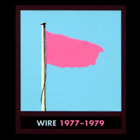Review
Wire
1977-1979
Turn back the clock 30 years. A pitiful punk band is ejected from The Roxy—the iconic punk venue of the time. Soon after, founder member George Gill breaks a leg while drunkenly trying to steal a pub band's guitar amp. The remaining quartet seize the opportunity, ditching Gill's songs, lyrics and guitar solos, stripping everything back to a bare-bones approximation of punk, and Wire is born.
The following three years bring breakneck evolution—a band trying to attain the velocity required to forever leave behind the charred remains of punk rock. And so it is that Pink Flag tears through its 21 tracks in under 39 minutes, ripping apart the genre as it does so. Relentless guitars and sneering vocals recall punk's basic form, but the content of the words and knowing destruction of the pop song combine to create something very different to the output of Wire's contemporaries. And while hurried tracks lacking verses or choruses are often the order of the day (Field Day for the Sundays clocks in at a diminutive 28 seconds), aggressive, grim, unhurried efforts such as Reuters and Strange break up the frenetic nature of the album with a jolt, bringing to mind a punk band marching through treacle. One of Pink Flag's shining stars, however, is the glorious pop of Mannequin. Who would have thought that a band that fashioned the 'aggro' of 12XU could create something so sweet?
Chairs Missing is a quantum leap from Pink Flag. Although the vestiges of Wire's punk roots remain, they are forced into new shapes: Another the Letter largely replaces guitars with arpeggio keyboard loops, while Too Late's dense atmosphere makes most of Pink Flag's punkier numbers seem lightweight by comparison. Elsewhere, Mike Thorne's electronics provide new paths for Wire, enabling the band to produce the chilling, bleak Marooned—one of the most beautiful pieces by the quartet. And Wire continues on its mission to deconstruct pop: Outdoor Miner's one-and-a-half minutes of sickly sweet guitars, catchy melodies, and a lyric rather bizarrely culled from a BBC nature documentary, could have opened the door to the commercial success that subsequently eluded the band had EMI not got caught hyping it.
Undeterred by such events, 154 completed Wire's initial run of albums, before the band spectacularly self-destructed during the live shows that birthed Document and Eyewitness. The cracks were already showing by this point: the coherence so evident in Chairs Missing had been replaced by a schism, with the two sides of the band—the experimental (Gilbert and Lewis) and the pop/rock (Newman and Gotobed)—threatening to tear the album to shreds. The result is an uncomfortable album where a beautiful pop ode to a field in Des Moines, Map Ref. 41ºn 93ºw, and catchy new wave effort The 15th rub shoulders with harrowing experimental composition The Other Window and epic soundscape A Mutual Friend. The brutal way in which the album lurches from one end of the music spectrum to the other is fascinating, and although it's perhaps not as fulfilling and consistent as Chairs Missing, 154 nonetheless remains a classic album.
Studio albums are only part of the story, however, and so although 1977-1979 compiles reissues of Wire's first three albums (suitably housed in CD-sized reproductions of vinyl sleeves), it also offers two extra CDs and a 60-page booklet. The booklet provides an incisive insight into Wire at the time, delving into previously unearthed nooks and crannies, and is essential to the more rampant fans of the band. And for those not quite as well versed in Wire lore, it should provide an interesting overview to a band that's been so cruelly overlooked over the years.
The two CDs concentrate on 'bridging the gaps', in a similar way to Wire's On the Box CD/DVD set. Whereas that separately available item effectively plugs the gap between Chairs Missing and 154, Live at CBGB finds Wire grappling with post-Pink Flag material, but without the production input of Mike Thorne. It's a more fragile Wire, but the tracks hold up well against the more luxurious versions on the studio album. The other disc is Live at the Roxy, compiling Wire's two nights at the club, prior to the recording of Pink Flag. This, too, is a Wire in transition, moving from Gill's heavy-handed material (hence the rather dubious Mary is a Dyke) to the more streamlined, angular efforts that would become the band's staple.
1977-1979 somehow seems more than the sum of its parts. On the surface, it's the original three albums, stripped of their bonus tracks (due to licensing reasons), but augmented by a couple of live CDs and a booklet. But sitting on your shelf, next to On the Box, it's a part of music's history. The case for purchase might not be clear-cut for anyone already in possession of the 1994 reissues of Wire's '70s work, but for anyone who lacks one or more of those albums, is lumbered with the disastrous Restless versions, or wants to peer into the spaces in-between, this is a fantastic set.
Craig Grannell (June, 2006)
